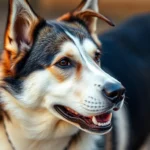
Introduction
Exploring the world of dog breeds reveals the rich variety of companions available to us. Each breed comes with its unique characteristics, history, and purpose, making understanding them crucial for potential owners. One breed that stands out in terms of versatility and charm is the Mountain Feist.
The Mountain Feist is a small, energetic breed known for its hunting prowess and close companionship with humans. With its roots steeped in American history, particularly in the Appalachian region, the Mountain Feist has evolved to become a beloved family pet and an adept hunting partner. This article will delve deep into the characteristics, history, and care needs of the Mountain Feist, providing valuable insights for anyone considering adding one to their family.
What is a Mountain Feist?
The Mountain Feist is a small hunting dog recognized for its agility and keen sense of smell. Characterized by a sturdy build, these dogs typically stand between 12 to 18 inches tall and weigh between 15 to 30 pounds. Their lively disposition makes them a favorite among active households.
Distinctive Features and Traits
This breed has a short, dense coat that comes in various colors, including brindle, black, and tri-color patterns. One of the most distinctive features of the Mountain Feist is its expressive ears, which can be either erect or floppy. Their tails are often medium-length and may be straight or slightly curved, adding to their playful appearance.
Purpose of the Mountain Feist
Originally bred for hunting small game, such as squirrels and rabbits, the Mountain Feist is known for its exceptional tracking skills and sharp instincts. Beyond their utility as hunting companions, they have also become cherished family pets, showcasing their versatility in both roles.
History and Origin of the Mountain Feist
The history of the Mountain Feist is rooted in the mountainous regions of the United States, particularly the Appalachian areas. This breed stems from a mix of various terrier breeds brought over by early settlers.
Geographic Origins and Development
As settlers moved westward, they brought their dogs with them, which eventually adapted to the rugged terrain and hunting demands of the new environment. The Mountain Feist became particularly valued among hunters for its ability to track and retrieve game in dense woods.
Evolution in America
Over the years, the Mountain Feist has evolved through selective breeding practices aimed at enhancing its hunting capabilities and temperament. Despite its development as a hunting breed, it has maintained its popularity as a family companion, showcasing its dual purpose.
Physical Characteristics
When it comes to the physical attributes of the Mountain Feist, there are several key characteristics to note.
Size and Weight Range
Typically, this breed ranges from 12 to 18 inches in height and weighs between 15 to 30 pounds. Their compact size makes them suitable for various living environments, from apartments to larger homes.
Coat Type and Colors
The coat of the Mountain Feist is short and dense, requiring minimal grooming. Colors can vary widely, including standard black, brown, and a mix of these shades in brindle patterns. This variety adds to their appeal among dog lovers.
Distinctive Physical Traits
In addition to their coat, the Mountain Feist is characterized by its strong, muscular build and expressive face. Their ears can either be erect or floppy, giving them a unique appearance. The tail is usually medium in length and can be carried high, reflecting their alert nature.
Comparison with Similar Breeds
While the Mountain Feist shares some similarities with breeds like the Jack Russell Terrier and the Rat Terrier, it is distinguished by its unique combination of size, temperament, and history. The Mountain Feist typically has a more laid-back personality compared to the often hyperactive nature of the Jack Russell.
Temperament and Personality
The temperament of the Mountain Feist is one of its most appealing traits.
General Temperament Traits
These dogs are known for their friendly and affectionate nature. They tend to form strong bonds with their families and are particularly good with children, making them excellent family pets. Their playful demeanor adds joy to any household.
Socialization Tendencies
Mountain Feists are generally sociable dogs that get along well with other pets and animals. Early socialization is key to ensuring they develop a well-rounded personality. They thrive in environments where they can interact with people and other animals, contributing to their happy disposition.
Energy Levels and Activity Requirements
This breed has high energy levels and requires regular exercise to keep them physically and mentally stimulated. Daily walks, playtime in the yard, and engaging activities are crucial for maintaining their health and happiness.
Common Behavioral Traits
One common quirk of the Mountain Feist is their instinctual drive to chase small animals, a trait inherited from their hunting background. This behavior can be managed with proper training and socialization, but it’s important to keep them on a leash during walks in areas with wildlife.
Health and Lifespan
Understanding the health and lifespan of the Mountain Feist is essential for potential owners.
Common Health Issues
Generally, the Mountain Feist is a hardy breed with few major health concerns. However, like all breeds, they may be prone to certain issues, including hip dysplasia, eye problems, and dental issues. Regular veterinary check-ups can help catch and address these concerns early on.
Average Lifespan
The average lifespan of a Mountain Feist is typically between 12 to 15 years. Factors such as genetics, diet, exercise, and overall care play significant roles in determining longevity.
Importance of Regular Veterinary Care
Routine veterinary care is crucial for maintaining the health of the Mountain Feist. Regular vaccinations, dental care, and preventive treatments for parasites can significantly enhance their quality of life and extend their lifespan.
Training and Exercise Needs
Training is vital for the Mountain Feist, given its energetic nature and intelligence.
Importance of Training
Training not only helps to instill good behavior but also strengthens the bond between the dog and its owner. These dogs are eager to please, making them relatively easy to train with positive reinforcement techniques.
Recommended Training Techniques
Methods such as clicker training or reward-based training work exceptionally well with the Mountain Feist. Consistency and patience are essential, as these dogs respond best to gentle guidance rather than harsh corrections.
Exercise Requirements
Due to their high energy levels, Mountain Feists require at least 30 to 60 minutes of exercise each day. Activities can include walks, runs, fetch, and even agility training, which provides both physical and mental stimulation.
Tips for Mental Stimulation
Incorporating puzzle toys or interactive games into playtime can help keep the Mountain Feist mentally engaged. Activities that encourage problem-solving will not only tire them out but also enhance their cognitive skills.
Nutrition and Diet
Providing a balanced diet is crucial for the health of the Mountain Feist.
Overview of Dietary Needs
These dogs benefit from a high-quality diet rich in protein, fats, and essential nutrients. Their food should cater to their energy levels and size, ensuring they receive the right balance for optimal health.
Recommended Types of Food
Options include dry kibble, high-quality wet food, or a raw diet, depending on the owner’s preference. Selecting a food that lists real meat as the first ingredient is advisable, ensuring that the dog receives adequate protein.
Portion Sizes and Feeding Schedule
Portion sizes should be based on the dog’s weight, age, and activity level. Typically, adult Mountain Feists do well with two meals per day, while puppies may require three to four smaller meals.
Importance of a Balanced Diet
A well-balanced diet not only supports physical health but also impacts energy levels and overall behavior. Regularly monitoring a Mountain Feist’s diet can prevent obesity and associated health issues.
Living with a Mountain Feist
Creating a harmonious living environment for the Mountain Feist involves understanding their needs.
Ideal Living Conditions
This breed thrives in homes with ample space for exercise, whether that be a large yard or access to nearby parks. However, they can adapt to apartment living as long as they receive sufficient daily exercise.
Compatibility with Families
Mountain Feists are known for their friendly nature, making them great companions for families with children. Their playful and affectionate demeanor ensures that they get along well with kids and can be a wonderful addition to any family unit.
Grooming and Maintenance Needs
The grooming needs of the Mountain Feist are minimal due to their short coat. Regular brushing can help reduce shedding and keep their coat healthy. Bathing should be done as needed, typically every few months or when they get particularly dirty.
Common Challenges
One common challenge faced by owners is managing the Mountain Feist’s prey drive, as they may chase after small animals. Providing obedience training and socialization from an early age can help mitigate this behavior.
Conclusion
The Mountain Feist is a remarkable breed that offers companionship, loyalty, and fun. With a rich history rooted in hunting, these dogs have proven themselves as versatile and loving family pets. Their energetic nature, coupled with their affectionate temperament, makes them an excellent choice for active households.
Understanding the specific needs and characteristics of the Mountain Feist is crucial for potential owners. From training and nutrition to exercise and socialization, these factors play integral roles in ensuring a happy and healthy life for these delightful dogs.
For those considering adding a Mountain Feist to their family, it’s important to take the time to learn about their unique requirements and characteristics. Doing so will lead to a fulfilling relationship with this wonderful breed.









